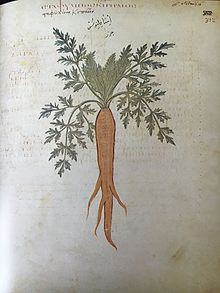1. Carrot / Wortel
HistoryBoth written history and molecular genetic studies indicate that the domestic carrot has a single origin in Central Asia. Its wild ancestors probably originated in Persia (regions of which are now Iran and Afghanistan), which remains the centre of diversity for the Wild Carrto Daucus carota. A naturally occurring subspesies of the wild carrot was presumably bred over the centuries to reduce bitterness, increase sweetness and minimise the woody core; this process produced the familiar garden vegetable.
When they were first cultivated, carrots were grown for their aromatic leaves and seeds rather than their roots. Carrot seeds have been found in Switzerland and Southern Germany dating back to 2000–3000 BC.ome close relatives of the carrot are still grown for their leaves and seeds, such as parsley, cilantro,coriander, fennel, anise, dill and cumin. The first mention of the root in classical sources is from the 1st century AD; the Romans ate a root vegetable called pastinaca,which may have been either the carrot or the closely related parnship.
The plant is depicted and described in the Eastern, a 6th-century AD Constantinopolitan copy of the Greek physician Dioscorides' 1st-century pharmacopoeia of herbs and medicines, De Materia Medica. Three different types of carrots are depicted, and the text states that "the root can be cooked and eaten".
Nutrition
The water content can vary from around 86-95%, and the edible portion consists of around 10% carbohydrates.
Carrots contain very little fat and protein.
One medium, raw carrot (61 grams) contains 25 calories, with only 4 grams of digestible carbs.
Nutrition Facts: Carrots, raw - 100 gramsAmount
Calories 41
Water 88 %
Protein 0.9 g
Carbs 9.6 g
Sugar 4.7 g
Fiber 2.8 g
Fat 0.2 g
Saturated 0.04 g
Monounsaturated 0.01 g
Polyunsaturated 0.12 g
Omega-3 0 g
Omega-6 0.12 g
Trans fat ~
2. Radish / Lobak
History
Varieties of radish are now broadly distributed around the world, but almost no records are available to help determine their early history and domestication.[3]However, scientists tentatively locate the origin of Raphanus sativus in southeast Asia, as this is the only region where truly wild forms have been discovered. India, central China, and Central Asiaappear to have been secondary centers where differing forms were developed. Radishes enter the historical record in third century BC.
Greek BC.Roman agriculturalists of the first century AD gave details of small, large, round, long, mild, and sharp varieties. The radish seems to have been one of the first European crops introduced to the Americas. A German botanist reported radishes of 100 lb (45 kg) and roughly 3 ft (90 cm) in length in 1544, although the only variety of that size today is the Japanese Sakurajima radish.[5]The large, mild, and white East Asian form was developed in China, though is mostly associated in the West with the Japanese daikon, owing to Japanese agricultural development and larger exports.
Nutrition:
Calories 12 calories
Protein 0.35 g
Carbohydrates 2.0 g
Dietary Fiber 1 g
Potassium 134.56 mg
Folate 15.66 mcg
Calories 12 calories
Protein 0.35 g
Carbohydrates 2.0 g
Dietary Fiber 1 g
Potassium 134.56 mg
Folate 15.66 mcg
3. Chayote / Labu Siam
Histroy
In the most common variety, the fruit is roughly pear-sh, somewhat flattened and with coarse wrinkles, ranging from 10 to 20 cm in length. It looks like a green pear, and it has a thin, green skin fused with the green to white flesh, and a single, large, flattened pit. varieties have spiny fruits. The flesh has a fairly bland taste, and a texture is described as a cross between a potato and a cucumber.
The chayote vine can be grown on the ground, but as a climbing plant, it will grow onto anything, and can easily rise as high as 12 meters when support is provided. It has heart-shaped leaves, 10–25 cm wide and tendrils on the stem. The plant bears male flowers in clusters and solitary female flowers.he plant’s fruit is light green and elongated with deep ridges lengthwise
Nutrition :






No comments:
Post a Comment